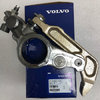So pretty much I have to use the head from the existing (newer style) engine, provided they are interchangeable. That would seem to solve both the EGR and injector issues, right? But, I hate to buy a complete, running engine and then have to track down a head. The existing head is no good, per my engine shop. At a glance, I didn't see much seriously wrong with it. Cylinder #1 has had 3 of the 4 valves replaced, indicating there was something bad going on there, but unless I sent it to a head shop for inspection, I can't know for sure it's truly scrap. I suppose I could try to sell the head from the purchased engine and recover some of the cost. Seems like a lot of trouble to get where I'm going. So far though, I haven't had much success locating a replacement engine. It all started with what we all thought was excessive blowby from a worn out engine in need of a rebuild. Teardown revealed different.
John, that's the million dollar question....what happens if the ECU from the newer machine does detect a lack of EGR? If it's not required, I'm willing to forego it. But if, as funwithfuel says, other issues arise, then that's not the right answer. Or as you mentioned, I can't run in limp mode or deal with a total shutdown.
Maybe someone needs to take away my shovel. I seem to be digging myself in deeper and deeper. I wish I could just locate the proper engine.






